Fire alarm systems are indispensable safety tools that safeguard lives and property by alerting individuals to fire emergencies. This guide delves deep into their workings, types, installation standards, and more to provide you with a thorough understanding of these systems.
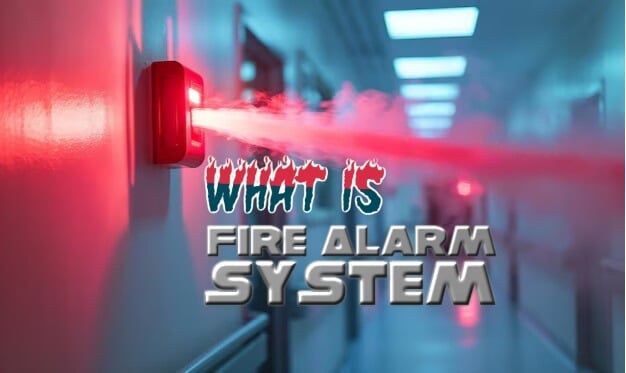
What is a Fire Alarm System?
A fire alarm system is a network of devices designed to detect and alert occupants of a building to the presence of fire, smoke, or other related emergencies. These systems are essential for ensuring rapid response and evacuation, minimizing potential injuries and damage.
Key Components of a Fire Alarm System

The Key Components of a Fire Alarm System are:
- Control Panel
- Detectors/Sensors
- Alarm Devices
- Manual Call Points
- Power Supply
1.    Control Panel
The control panel acts as the brain of the system. It processes inputs from detectors and manual call points to activate alarm devices. Modern panels also support remote monitoring and diagnostics. For instance, addressable control panels can identify the exact location of a triggered detector.
2.    Detectors
Detectors are the sensory components that identify signs of a fire. Some of them include:
- Smoke Detectors: Use optical or ionization techniques to sense smoke particles.
- Heat Detectors: Measure temperature changes and trigger alarms when a set threshold is exceeded. These are ideal for areas like kitchens.
- Flame Detectors: Use infrared or ultraviolet sensors to detect flames directly, making them suitable for industrial applications.
3.    Alarm Devices
These include bells, sirens, and strobe lights that alert occupants to evacuate. Advanced systems use voice evacuation messages to provide clear instructions during emergencies.
4.    Manual Call Points
Also known as break-glass points, these allow individuals to manually activate the alarm. They are strategically placed near exits and in high-traffic areas for quick access.
5.    Power Supply
Fire alarm systems rely on a primary power source (electricity) and a backup source, such as batteries or generators, to ensure continuous operation during power outages.
How Does a Fire Alarm System Work?
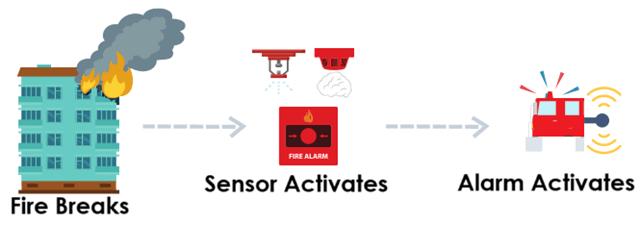
Fire alarm systems operate in three key stages:
- Detection:Â Detectors identify smoke, heat, or flames using specific technologies. For instance:
- Optical smoke detectors use light scattering to detect smoke particles.
- Heat detectors employ thermistors to monitor temperature rises.
- Alert: The control panel receives signals from detectors and activates alarm devices. In addressable systems, the panel can specify the exact location of the triggered device.
- Response: Occupants evacuate the building, and emergency services are notified. Some advanced systems automatically activate fire suppression systems like sprinklers.
For example, in a warehouse equipped with a hybrid system, wireless detectors in remote sections can identify a fire and relay information to the central control panel for immediate action.
Main Types of Fire Alarm Systems
Fire alarm systems can be categorized based on functionality and configuration:
-
Conventional Fire Alarm Systems
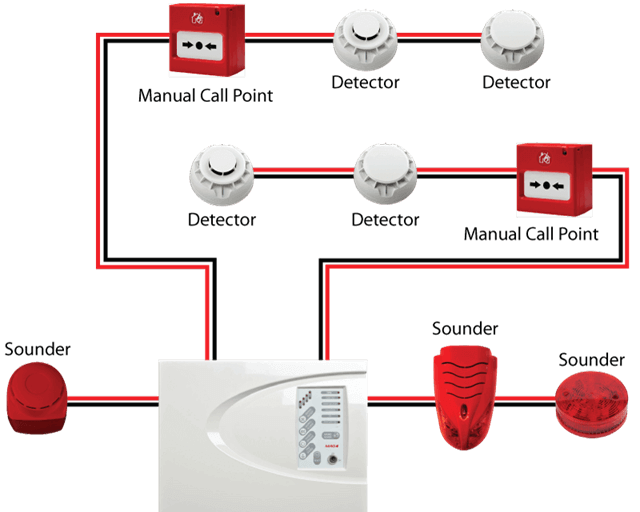
These systems divide the building into zones. When an alarm is triggered, the control panel identifies the affected zone but not the exact location of the fire. This simplicity makes them cost-effective and suitable for small buildings.
Example: In a school, a conventional system might signal a fire in the “Science Block” zone without pinpointing the specific classroom.
-
Addressable Fire Alarm Systems
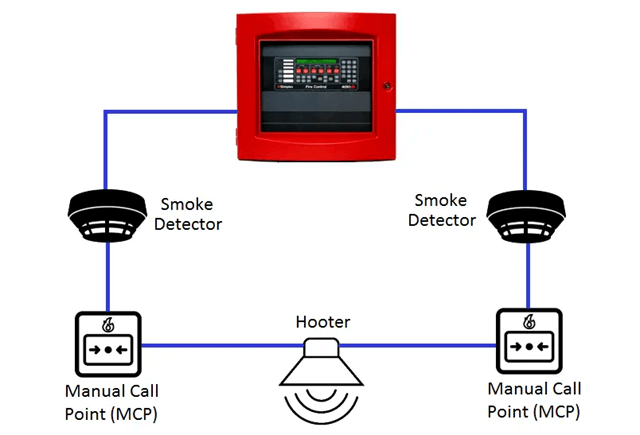
Each device has a unique address, enabling precise identification of the triggered detector. These systems are ideal for larger, complex structures where pinpointing the exact location of a fire is crucial.
Example: An addressable system in a hospital can identify a fire in “Room 205, Ward B,” ensuring faster evacuation and response.
-
Wireless Fire Alarm Systems

Wireless systems use radio frequency signals to communicate between devices. They are easy to install and ideal for buildings where wiring is impractical, such as heritage sites.
Example: A museum installs a wireless fire alarm system to preserve its historical architecture.
-
Hybrid Fire Alarm Systems

Combining wired and wireless components, hybrid systems offer flexibility and scalability. They are suitable for expanding facilities where some areas require wireless connectivity.
| Feature | Conventional | Addressable | Wireless | Hybrid |
| Location Detection | Zone-Based | Device-Specific | Device-Specific | Device-Specific |
| Installation Cost | Low | High | Moderate | High |
| Flexibility | Limited | Moderate | High | High |
| Maintenance Complexity | Low | High | Moderate | Moderate |
Standards to Be Followed While Installing Fire Alarm Systems
Adhering to safety standards ensures optimal performance and compliance with legal requirements. Key standards include:
1. NFPA 72 (National Fire Alarm and Signaling Code)
- Covers installation, performance, and maintenance.
- Addresses fire alarms in industrial, commercial, and residential spaces.
- Specifies wiring, detector placement, and testing protocols.
2. BS 5839 (British Standard)
- Provides guidance for design and installation in the UK.
- Emphasizes the importance of regular maintenance and documentation.
3. ISO 7240
- International standard covering fire detection systems with global applicability.
- Focuses on system reliability and interoperability.
Professional consultation and compliance with these standards ensure the system’s reliability and legal adherence.
What Are L1, L2, and L3 Fire Alarm Systems?
The levels of fire alarm systems—L1, L2, and L3—define the coverage areas and the intended purpose of the system, primarily outlined by BS 5839 standards. The choice among these levels depends on the building’s risk assessment, size, and intended usage.
| Feature | L1 Fire Alarm System | L2 Fire Alarm System | L3 Fire Alarm System |
| Coverage | All rooms and spaces | High-risk areas and escape routes | Escape routes and circulation |
| Ideal Applications | Hospitals, hotels, malls | Schools, offices | Small offices, residential |
| Protection Priority | Maximum life and property | Targeted risk management | Evacuation safety |
L1 Fire Alarm Systems
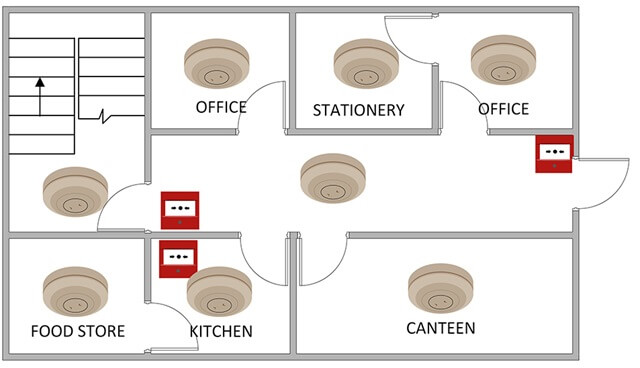
An L1 fire alarm system offers the highest level of coverage, with detectors installed in every room, hallway, and void space. This system is suitable for high-risk environments such as hospitals, large hotels, and shopping malls, where comprehensive detection is essential to ensure both life safety and property protection.
For example, in a large hotel, an L1 system ensures early detection of fire in any guest room, corridor, or service area, allowing for swift evacuation and response.
L2 Fire Alarm Systems
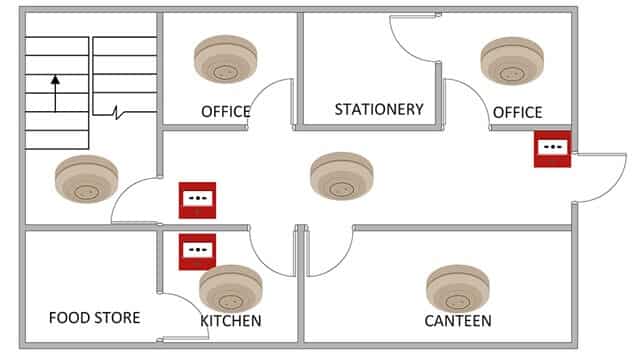
An L2 system focuses on high-risk areas while also covering escape routes. Detectors are placed in locations such as kitchens, boiler rooms, and workshops—spaces more prone to fire outbreaks. In addition, key escape routes like staircases and hallways are monitored to ensure safe evacuation. This setup is ideal for schools, office buildings, and medium-risk environments.
For instance, in a school, detectors in science labs and kitchens, combined with coverage of evacuation paths, create an effective balance of safety and practicality.
L3 Fire Alarm Systems

An L3 system prioritizes escape routes and circulation areas, ensuring that occupants can safely exit the building in the event of a fire. While it does not provide coverage for every room, it is sufficient for smaller buildings with low fire risks, such as small offices or residential blocks.
For example, in a small office, an L3 system would focus on hallways and stairwells, providing cost-effective yet adequate protection for occupants.
Types of Fire Detectors/Sensors
Fire detectors or sensors are essential components of any fire alarm system, designed to detect signs of fire such as smoke, heat, or flames. Selecting the appropriate type of fire detector depends on the specific requirements of a building or environment.
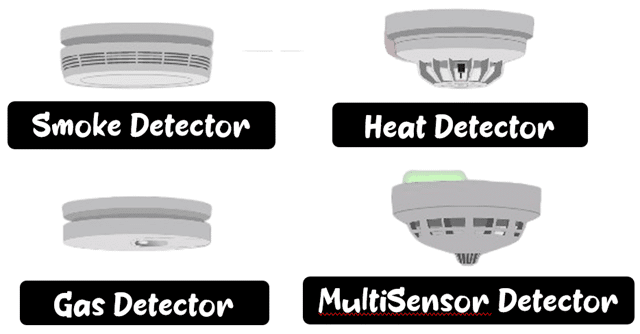
1. Smoke Detectors
Smoke detectors are designed to sense the presence of smoke, often an early indicator of fire. They are commonly used in residential, commercial, and industrial settings.
Types of Smoke Detectors:
Following are the Main Smoke Detectors in Use:
Ionization Smoke Detectors:
- Working Principle: Ionization detectors use a small amount of radioactive material between two electrically charged plates to create an ionization chamber. When smoke enters, it disrupts the flow of ions, reducing the current and triggering the alarm.
- Best Use Case: Effective for detecting fast-flaming fires with minimal smoke.
- Applications: Warehouses, factories, and areas prone to rapid-fire spread.
Photoelectric Smoke Detectors:
- Working Principle: These detectors use a light source and a photosensitive sensor. When smoke particles scatter the light beam, it deflects onto the sensor, triggering the alarm.
- Best Use Case: Suitable for detecting smoldering fires with thick smoke.
- Applications: Offices, residential spaces, and areas with combustible materials.
Dual-Sensor Smoke Detectors:
- Working Principle: Combine ionization and photoelectric technologies to detect both fast-flaming and smoldering fires.
- Applications: Ideal for environments requiring comprehensive coverage, such as schools and hospitals.
2. Heat Detectors
Heat detectors respond to temperature changes or exceedances of a predetermined threshold. They are less sensitive than smoke detectors but effective in specific environments.
Types of Heat Detectors:
Following are the Main Heat Detectors in Use:
Fixed Temperature Heat Detectors:
- Working Principle: Trigger an alarm when the ambient temperature exceeds a preset limit, typically around 135°F (57°C).
- Applications: Kitchens, boiler rooms, and industrial spaces with fluctuating temperatures.
Rate-of-Rise Heat Detectors:
- Working Principle: Detect rapid increases in temperature, regardless of whether a fixed threshold is reached.
- Applications: Ideal for areas where sudden temperature changes occur, such as manufacturing units.
3. Flame Detectors
Flame detectors specialize in detecting the presence of flames by analyzing the infrared (IR), ultraviolet (UV), or visible light spectrum.
Types of Flame Detectors:
Following are the Main Flame Detectors in Use:
UV Flame Detectors:
- Working Principle: Detect ultraviolet radiation emitted by flames.
- Applications: Suitable for fast-response scenarios in gas and oil facilities, laboratories, and power plants.
IR Flame Detectors:
- Working Principle: Detect infrared radiation produced by flames. Some advanced detectors can ignore background IR sources.
- Applications: Used in outdoor environments, petrochemical industries, and refineries.
UV/IR Flame Detectors:
- Working Principle: Combine UV and IR detection for enhanced accuracy and reduced false alarms.
- Applications: Critical areas such as chemical plants and aircraft hangars.
4. Gas Detectors
Gas detectors identify the presence of hazardous gases that could lead to fire or explosions.
Types of Gas Detectors:
Following are the Gas Detectors in Use:
 Combustible Gas Detectors:
- Working Principle: Detect gases such as methane or propane that can ignite and cause fire.
- Applications: Industrial facilities, oil refineries, and gas pipelines.
Toxic Gas Detectors:
- Working Principle: Detect toxic gases like carbon monoxide or hydrogen sulfide.
- Applications: Underground parking garages, chemical plants, and confined spaces.
5. Multi-Sensor Detectors
Multi-sensor detectors combine various detection technologies, such as smoke, heat, and gas sensors, to enhance accuracy and reduce false alarms.
- Working Principle: Use algorithms to analyze data from multiple sensors and differentiate between fire and non-fire incidents.
- Applications: Ideal for complex environments like airports, data centers, and shopping malls.
Comparison Table: Fire Detectors at a Glance
| Type | Working Principle | Best For | Applications |
| Ionization Smoke | Ionization chamber disrupted by smoke | Fast-flaming fires | Warehouses, factories |
| Photoelectric Smoke | Light scattering caused by smoke | Smoldering fires | Offices, residential spaces |
| Dual-Sensor Smoke | Combines ionization and photoelectric | Comprehensive fire detection | Schools, hospitals |
| Fixed Heat | Alarm at preset temperature | High-temperature areas | Kitchens, boiler rooms |
| Rate-of-Rise Heat | Rapid temperature increase detection | Sudden heat changes | Manufacturing units |
| UV Flame | Detects ultraviolet radiation from flames | Fast-response scenarios | Gas and oil facilities |
| IR Flame | Detects infrared radiation from flames | Outdoor and industrial applications | Refineries, petrochemical industries |
| UV/IR Flame | Combines UV and IR detection | Enhanced accuracy | Chemical plants, aircraft hangars |
| Gas | Detects combustible or toxic gases | Gas leak and fire prevention | Industrial facilities, confined spaces |
| Multi-Sensor | Combines smoke, heat, and gas detection | Complex environments | Airports, data centers, shopping malls |
Top 10 Frequently Asked Questions on Fire Alarm Systems
- How often should fire alarms be tested?
Fire alarms should be tested monthly to check basic functionality. Professional inspections and maintenance should be conducted annually to ensure compliance with safety standards.
- Can fire alarms work without electricity?
Yes, fire alarm systems have battery backups or secondary power supplies to maintain operation during power outages.
- What is the lifespan of a fire alarm system?
The system’s components typically last 10-15 years, but detectors may require replacement every 5-10 years based on usage and manufacturer guidelines.
- What triggers false alarms?
Common causes include cooking fumes, dust accumulation, humidity, or improper placement near vents or kitchens. Regular maintenance helps mitigate these issues.
- Are fire alarm systems mandatory?
Yes, most countries mandate fire alarm systems in residential, commercial, and industrial buildings to ensure occupant safety and compliance with building codes.
Read More: What is Obsolescence – How it Happens, its Criticality and Types Reliability Engineering Overview

66vgow
1j3s9k
I likewise think hence, perfectly composed post! .
bmzu40
fjudq1
3ed3e3
o2cp13
5qdcnv
There is clearly a bunch to identify about this. I assume you made various nice points in features also.
4gz01y
e6s4f8
Pretty nice post. I simply stumbled upon your blog and wanted to mention that I’ve truly loved surfing around your weblog posts. In any case I’ll be subscribing for your feed and I am hoping you write once more very soon!
I got what you intend,saved to favorites, very decent internet site.
krfjqb
Order Adderall Online Overnight Delivery
I see something genuinely interesting about your weblog so I saved to fav.
Buy Adderall IR Online
o6qkyy
8pq68o
5ek17d
It is the best time to make some plans for the future and it is time to be happy. I’ve read this post and if I could I desire to suggest you some interesting things or suggestions. Perhaps you could write next articles referring to this article. I desire to read even more things about it!
I’m curious to find out what blog platform you are using? I’m experiencing some minor security problems with my latest blog and I’d like to find something more safe. Do you have any recommendations?
4siwlw
ksnqom
9wso4a
I discovered your blog site on google and check a few of your early posts. Continue to keep up the very good operate. I just additional up your RSS feed to my MSN News Reader. Seeking forward to reading more from you later on!…
Hi there just wanted to give you a brief heads up and let you know a few of the pictures aren’t loading properly. I’m not sure why but I think its a linking issue. I’ve tried it in two different browsers and both show the same outcome.
bx9bmw
Purchase Adderall Online
41w92e
Order Adderall Online
32c192
I like what you guys are up too. Such intelligent work and reporting! Keep up the superb works guys I¦ve incorporated you guys to my blogroll. I think it’ll improve the value of my website 🙂
Do you mind if I quote a few of your posts as long as I provide credit and sources back to your webpage? My website is in the exact same area of interest as yours and my users would genuinely benefit from a lot of the information you present here. Please let me know if this okay with you. Thank you!
Nice weblog here! Also your site loads up very fast! What web host are you using? Can I am getting your affiliate hyperlink to your host? I want my website loaded up as quickly as yours lol
Everything is very open and very clear explanation of issues. was truly information. Your website is very useful. Thanks for sharing.
Almost all of whatever you point out happens to be supprisingly appropriate and it makes me wonder why I had not looked at this with this light before. This piece truly did turn the light on for me personally as far as this subject matter goes. Nevertheless at this time there is actually one particular position I am not necessarily too cozy with so while I attempt to reconcile that with the core theme of the issue, permit me see exactly what all the rest of your readers have to say.Very well done.
I have learned some new things through your blog post. One more thing to I have found is that normally, FSBO sellers will certainly reject people. Remember, they would prefer to not ever use your providers. But if an individual maintain a gradual, professional partnership, offering aid and staying in contact for four to five weeks, you will usually manage to win an interview. From there, a house listing follows. Many thanks
I’m glad I found this webpage. I was looking for another website when I stumbled on it. Nice work.
I have been absent for some time, but now I remember why I used to love this site. Thank you, I?¦ll try and check back more often. How frequently you update your website?
Thanks a lot for the helpful article. It is also my belief that mesothelioma cancer has an very long latency phase, which means that signs and symptoms of the disease may not emerge until finally 30 to 50 years after the initial exposure to asbestos fiber. Pleural mesothelioma, that is the most common form and is affecting the area across the lungs, could potentially cause shortness of breath, chest muscles pains, and a persistent cough, which may result in coughing up our blood.
Hi my friend! I want to say that this post is awesome, nice written and include approximately all important infos. I?d like to see more posts like this.
Great post made here. One thing I’d like to say is always that most professional fields consider the Bachelor Degree as the entry level requirement for an online certification. Although Associate Qualifications are a great way to get started, completing the Bachelors presents you with many entrance doors to various professions, there are numerous internet Bachelor Diploma Programs available via institutions like The University of Phoenix, Intercontinental University Online and Kaplan. Another thing is that many brick and mortar institutions give Online versions of their degree programs but normally for a extensively higher cost than the companies that specialize in online higher education degree programs.
Hiya! I know this is kinda off topic however , I’d figured I’d ask. Would you be interested in exchanging links or maybe guest authoring a blog post or vice-versa? My blog goes over a lot of the same subjects as yours and I believe we could greatly benefit from each other. If you happen to be interested feel free to shoot me an e-mail. I look forward to hearing from you! Terrific blog by the way!
Thanks for the posting. I have always seen that most people are desirous to lose weight as they wish to show up slim along with attractive. Nevertheless, they do not always realize that there are more benefits so that you can losing weight additionally. Doctors insist that obese people experience a variety of conditions that can be instantly attributed to their own excess weight. The great news is that people that are overweight as well as suffering from a variety of diseases can help to eliminate the severity of their own illnesses through losing weight. It’s possible to see a slow but marked improvement with health as soon as even a negligible amount of weight loss is attained.
Hello! Would you mind if I share your blog with my myspace group? There’s a lot of people that I think would really appreciate your content. Please let me know. Thank you
hey there and thank you for your information ? I have certainly picked up something new from right here. I did however expertise several technical points using this web site, since I experienced to reload the site lots of times previous to I could get it to load properly. I had been wondering if your hosting is OK? Not that I’m complaining, but slow loading instances times will often affect your placement in google and can damage your high quality score if advertising and marketing with Adwords. Anyway I am adding this RSS to my email and can look out for much more of your respective fascinating content. Ensure that you update this again soon..
My brother recommended I might like this website. He was entirely right. This submit actually made my day. You cann’t imagine simply how so much time I had spent for this info! Thanks!
Howdy I am so happy I found your webpage, I really found you by mistake, while I was researching on Yahoo for something else, Regardless I am here now and would just like to say thank you for a remarkable post and a all round exciting blog (I also love the theme/design), I don’t have time to go through it all at the minute but I have saved it and also added in your RSS feeds, so when I have time I will be back to read a lot more, Please do keep up the great job.
You could definitely see your enthusiasm within the paintings you write. The sector hopes for even more passionate writers like you who are not afraid to mention how they believe. All the time go after your heart.
Some times its a pain in the ass to read what website owners wrote but this website is real user genial! .
This article is absolutely incredible! The author has done a fantastic job of delivering the information in an captivating and enlightening manner. I can’t thank him enough for sharing such precious insights that have undoubtedly enhanced my knowledge in this topic. Kudos to him for crafting such a gem!
Can I just say what a relief to find someone who actually knows what theyre talking about on the internet. You definitely know how to bring an issue to light and make it important. More people need to read this and understand this side of the story. I cant believe youre not more popular because you definitely have the gift.
Wonderful items from you, man. I have remember your stuff previous to and you are just too excellent. I actually like what you’ve got right here, really like what you are stating and the way in which through which you assert it. You are making it enjoyable and you continue to care for to stay it wise. I cant wait to read much more from you. This is really a great site.
There’s noticeably a bundle to learn about this. I assume you made sure nice points in options also.
F*ckin? tremendous things here. I am very glad to see your article. Thanks a lot and i am looking forward to contact you. Will you kindly drop me a e-mail?
Oh my goodness! an incredible article dude. Thank you Nevertheless I am experiencing difficulty with ur rss . Don’t know why Unable to subscribe to it. Is there anybody getting identical rss drawback? Anybody who knows kindly respond. Thnkx
Thanks for the points you have provided here. Something important I would like to express is that pc memory specifications generally increase along with other innovations in the engineering. For instance, as soon as new generations of cpus are made in the market, there’s usually a similar increase in the size and style demands of both personal computer memory and hard drive space. This is because the application operated by simply these processor chips will inevitably increase in power to take advantage of the new technological know-how.
Great ? I should certainly pronounce, impressed with your web site. I had no trouble navigating through all the tabs as well as related info ended up being truly simple to do to access. I recently found what I hoped for before you know it in the least. Quite unusual. Is likely to appreciate it for those who add forums or anything, website theme . a tones way for your client to communicate. Nice task..
An added important area is that if you are a senior citizen, travel insurance intended for pensioners is something you must really consider. The more mature you are, the greater at risk you will be for allowing something awful happen to you while overseas. If you are not necessarily covered by several comprehensive insurance, you could have some serious issues. Thanks for revealing your ideas on this weblog.
great submit, very informative. I wonder why the other experts of this sector don’t realize this. You should continue your writing. I’m confident, you have a huge readers’ base already!
A person essentially help to make seriously posts I would state. This is the very first time I frequented your web page and thus far? I surprised with the research you made to make this particular publish amazing. Magnificent job!
I acquired more interesting things on this weight-loss issue. One particular issue is a good nutrition is highly vital while dieting. A big reduction in bad foods, sugary meals, fried foods, sweet foods, pork, and white flour products might be necessary. Possessing wastes unwanted organisms, and toxic compounds may prevent ambitions for fat-loss. While certain drugs momentarily solve the condition, the horrible side effects are certainly not worth it, and they never present more than a temporary solution. It’s a known incontrovertible fact that 95 of diet plans fail. Thank you for sharing your ideas on this web site.
Nice post. I study one thing tougher on different blogs everyday. It should always be stimulating to learn content from other writers and practice slightly one thing from their store. I?d desire to use some with the content on my weblog whether or not you don?t mind. Natually I?ll give you a hyperlink in your net blog. Thanks for sharing.
An added important area is that if you are a senior, travel insurance intended for pensioners is something that is important to really look at. The older you are, the greater at risk you’re for getting something negative happen to you while in most foreign countries. If you are certainly not covered by a number of comprehensive insurance policy, you could have several serious troubles. Thanks for giving your advice on this weblog.
One important issue is that while you are searching for a education loan you may find that you will want a co-signer. There are many scenarios where this is correct because you could find that you do not possess a past history of credit so the financial institution will require you have someone cosign the borrowed funds for you. Thanks for your post.
I simply couldn’t leave your website before suggesting that I extremely loved the standard information an individual supply in your visitors? Is going to be again ceaselessly to investigate cross-check new posts
Thanks for expressing your ideas listed here. The other thing is that when a problem arises with a pc motherboard, people should not take the risk with repairing the item themselves for if it is not done properly it can lead to irreparable damage to all the laptop. In most cases, it is safe to approach your dealer of your laptop with the repair of motherboard. They have got technicians who definitely have an expertise in dealing with pc motherboard challenges and can get the right prognosis and conduct repairs.
Generally I do not read post on blogs, but I wish to say that this write-up very forced me to try and do so! Your writing style has been amazed me. Thanks, very nice article.
Hello very nice blog!! Guy .. Beautiful .. Superb .. I will bookmark your site and take the feeds additionally?I am satisfied to find a lot of useful info right here within the post, we need work out more strategies on this regard, thanks for sharing. . . . . .
Hey There. I discovered your weblog the use of msn. That is an extremely smartly written article. I will be sure to bookmark it and come back to learn extra of your helpful information. Thanks for the post. I will definitely return.
I have realized that over the course of developing a relationship with real estate managers, you’ll be able to get them to understand that, in most real estate financial transaction, a fee is paid. Ultimately, FSBO sellers don’t “save” the percentage. Rather, they struggle to earn the commission by doing an agent’s task. In doing so, they expend their money plus time to carry out, as best they might, the tasks of an broker. Those assignments include disclosing the home by way of marketing, showing the home to all buyers, constructing a sense of buyer emergency in order to prompt an offer, organizing home inspections, managing qualification assessments with the mortgage lender, supervising repairs, and assisting the closing of the deal.
One more issue is that video gaming has become one of the all-time greatest forms of excitement for people of nearly every age. Kids play video games, plus adults do, too. Your XBox 360 has become the favorite games systems for people who love to have hundreds of video games available to them, in addition to who like to learn live with other folks all over the world. Many thanks for sharing your ideas.
Thanks for expressing your ideas. I’d personally also like to say that video games have been at any time evolving. Technology advances and innovative developments have aided create reasonable and interactive games. These kind of entertainment video games were not as sensible when the concept was first being used. Just like other styles of electronics, video games also have had to grow by many many years. This itself is testimony towards the fast development of video games.
Some tips i have observed in terms of computer system memory is that there are specifications such as SDRAM, DDR and so on, that must fit in with the specifications of the mother board. If the pc’s motherboard is pretty current while there are no operating-system issues, replacing the storage space literally normally takes under 1 hour. It’s on the list of easiest pc upgrade procedures one can consider. Thanks for revealing your ideas.
obviously like your website however you have to check the spelling on several of your posts. Many of them are rife with spelling problems and I to find it very bothersome to inform the truth then again I?ll surely come again again.
When I originally commented I clicked the “Notify me when new comments are added” checkbox and now each time a comment is added I get several e-mails with the same comment. Is there any way you can remove me from that service? Thanks a lot!
You could definitely see your skills within the paintings you write. The sector hopes for even more passionate writers like you who are not afraid to mention how they believe. At all times follow your heart.
Thanks for another great article. Where else could anyone get that type of information in such an ideal way of writing? I’ve a presentation next week, and I’m on the look for such info.
I can’t express how much I admire the effort the author has put into creating this outstanding piece of content. The clarity of the writing, the depth of analysis, and the wealth of information offered are simply impressive. His enthusiasm for the subject is evident, and it has undoubtedly made an impact with me. Thank you, author, for sharing your insights and enhancing our lives with this exceptional article!
I mastered more new things on this losing weight issue. A single issue is that good nutrition is extremely vital if dieting. A massive reduction in junk food, sugary meals, fried foods, sweet foods, beef, and white-colored flour products could be necessary. Keeping wastes parasites, and wastes may prevent aims for losing fat. While specified drugs momentarily solve the condition, the terrible side effects will not be worth it, they usually never give more than a non permanent solution. This can be a known idea that 95 of diet plans fail. Many thanks for sharing your ideas on this site.
You actually make it appear so easy together with your presentation however I in finding this topic to be really one thing which I feel I might never understand. It seems too complex and very wide for me. I am looking forward in your next put up, I?ll attempt to get the hang of it!
You really make it appear so easy together with your presentation but I to find this topic to be actually one thing that I believe I would never understand. It sort of feels too complex and extremely extensive for me. I am looking ahead for your next post, I?ll try to get the cling of it!
Really well written
excellent points altogether, you simply gained a brand new reader. What would you suggest about your post that you made some days ago? Any positive?
This is hands down one of the best articles I’ve read on this topic! The author’s thorough knowledge and passion for the subject are apparent in every paragraph. I’m so appreciative for finding this piece as it has enhanced my understanding and stimulated my curiosity even further. Thank you, author, for dedicating the time to produce such a outstanding article!
Thanks for the suggestions you are revealing on this web site. Another thing I would like to say is the fact that getting hold of some copies of your credit history in order to scrutinize accuracy of the detail is the first activity you have to carry out in credit improvement. You are looking to clean up your credit reports from harmful details flaws that damage your credit score.
I enjoy, cause I found just what I used to be having a look for. You’ve ended my four day lengthy hunt! God Bless you man. Have a great day. Bye
91p8nu
I’m amazed by the quality of this content! The author has obviously put a huge amount of effort into researching and arranging the information. It’s inspiring to come across an article that not only offers helpful information but also keeps the readers captivated from start to finish. Great job to him for creating such a remarkable piece!
It’s best to participate in a contest for probably the greatest blogs on the web. I will suggest this web site!
I’ve been browsing online more than three hours today, yet I never found any interesting article like yours. It’s pretty worth enough for me. In my opinion, if all website owners and bloggers made good content as you did, the web will be much more useful than ever before.
I can’t believe how amazing this article is! The author has done a fantastic job of presenting the information in an compelling and informative manner. I can’t thank him enough for offering such valuable insights that have certainly enlightened my knowledge in this topic. Hats off to her for producing such a masterpiece!
Thanks for your article. It is very unfortunate that over the last decade, the travel industry has already been able to to take on terrorism, SARS, tsunamis, flu virus, swine flu, plus the first ever real global economic collapse. Through it the industry has proven to be robust, resilient in addition to dynamic, obtaining new approaches to deal with difficulty. There are generally fresh difficulties and the possiblility to which the industry must just as before adapt and behave.
I like your quality that you put into your writing . Please do continue with more like this.
Great summary
We are a group of volunteers and opening a new scheme in our community. Your site provided us with valuable info to work on. You’ve done an impressive job and our whole community will be thankful to you.
This is a fantastic website, will you be interested in doing an interview regarding just how you developed it? If so e-mail me!
Howdy! Would you mind if I share your blog with my myspace group? There’s a lot of people that I think would really enjoy your content. Please let me know. Cheers
That is the appropriate blog for anyone who needs to search out out about this topic. You understand a lot its almost hard to argue with you (not that I actually would want…HaHa). You definitely put a brand new spin on a subject thats been written about for years. Great stuff, simply nice!
fantastic issues altogether, you simply gained a emblem new reader. What could you suggest about your put up that you just made some days in the past? Any sure?
Great write-up, I am regular visitor of one?s website, maintain up the excellent operate, and It’s going to be a regular visitor for a long time.
I will right away take hold of your rss feed as I can not in finding your e-mail subscription hyperlink or e-newsletter service. Do you’ve any? Please let me realize in order that I may just subscribe. Thanks.
It is really a great and helpful piece of information. I?m glad that you shared this helpful information with us. Please keep us informed like this. Thank you for sharing.
I do trust all of the concepts you’ve offered in your post. They are really convincing and will definitely work. Still, the posts are very brief for beginners. May you please prolong them a little from subsequent time? Thanks for the post.
whoah this blog is magnificent i like studying your posts. Stay up the good work! You understand, a lot of people are searching round for this information, you could aid them greatly.
I don?t even know how I ended up here, but I thought this post was good. I do not know who you are but definitely you’re going to a famous blogger if you are not already 😉 Cheers!
Heya! I just wanted to ask if you ever have any issues with hackers? My last blog (wordpress) was hacked and I ended up losing months of hard work due to no backup. Do you have any solutions to prevent hackers?